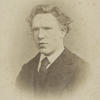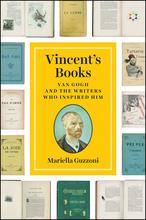More about Self-Portrait with a Japanese Print
- All
- Info
- Shop

Contributor
In 1851, an American set out to sea in search of coal and his journey eventually led to the opening of Japan to commercial and diplomatic relations with the Western world.
This access to Japan brought to the Western world Japanese culture and ukiyo-e prints that have influenced some of our favorite artists. Vincent Van Gogh once said, “All my work is based to some extent on Japanese art…” Aside for the minor issue of climate change brought about by the 17th century love for coal, it also brought ukiyo-e prints to Vincent Van Gogh and other artists.
Several western artists have been influenced by the Japanese ukiyo-e prints including Van Gogh, Toulouse-Lautrec, Emile Bernard to name a few. A particular westerner responsible for exposing these artists to Japanese prints was Matthew Perry. First coal, now Chandler Bing? Well, we’re actually speaking of Commodore Matthew Perry, the American naval officer, that led the U.S. naval expedition to Japan in hopes of establishing a commercial and diplomatic relationship with Japan.
At this moment, only the Chinese and the Dutch were allowed to trade with Japan. Although this wasn’t the first American attempt to gain access to Japan, it was, however, the first attempt backed by a President of the United States. At the moment, President Millard Fillmore sat in the White House. With the invention of the steam engine and the annexation of California, this attempt was fueled by a desire to establish trade routes in the Pacific. This meant coaling stations needed to be built so the ships could stop and fuel up on their voyage across the pacific. Other contributing factors were mistreatment of stranded American sailors by the reclusive nation, the expansion of the whaling industry, as well as a rumor that Japan was hiding a treasure trove of coal from the rest of the world.
Thus, Commodore Perry left on his treasure hunt to gain access to the coveted coal with a letter addressed to the Emperor of Japan, making his way through the peripheral Japanese islands and then finally to Edo. Of course, Perry was unaware that, at the moment, the Tokugawa Shogunate governed the island nation with the emperor as a mere figurehead. Perry landing in Japan with the letter to the Emperor completely unaware that the Tokugawa Shogunate actually governed the island might have been the most American thing he ever did.
President Fillmore’s letter explained that Commodore Perry was to “abstain from from every act which could possibly disturb the tranquility ” in Japan. After the initial contact, Perry returned six months later holding a letter with a much more aggressive tone and a larger, more intimidating fleet with over a hundred cannons to kindly request Japan accept the US offer. To that the Japanese government retorted: “Excuse me for quoting Twilight but ‘Your mood swings are giving me whiplash’ ”. Jokes aside, it's quite a feat that Perry succeeded in establishing a relationship with Japan, however aggressively it was accomplished. The Japanese government reluctantly agreed to the US proposal, eventually establishing the Treaty of Kanagawa and later, a commercial treaty in 1858. Europe soon followed suit in 1859, opening up trading routes from the Western world into Japan and opening up European artists like Van Gogh to ukiyo-e prints.
Sources
- “Inspiration from Japan,” Van Gogh Museum, accessed: February 25, 2018. https://www.vangoghmuseum.nl/en/stories/inspiration-from-japan#22
- “The United States and the Opening to Japan, 1853,” US Department of State: Office of the Historian, updated: June 1, 2017, accessed: February 25, 2018. https://history.state.gov/milestones/1830-1860/opening-to-japan
- “Letters From U.S. President Millard Fillmore And U.S. Navy Commodore Matthew C. Perry To The Emperor Of Japan (1852 - 1853),” Columbia University: Asia for Educators, accessed: February 25, 2018. http://afe.easia.columbia.edu/ps/japan/fillmore_perry_lett














